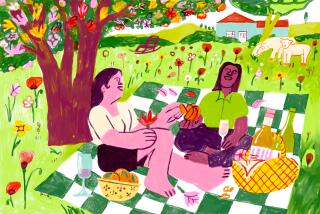Simply Reds
- Share via
Harry Waugh, the 90-year-old former director of Chateau Latour, was once asked how long it had been since he mistook a Bordeaux for a Burgundy.
Replied Waugh, “Not since lunch.”
Waugh isn’t alone. Even expert tasters, served wines unidentified and asked to name them, are often fooled. It’s happened to me, and it’s humbling. It’s just not easy to identify a specific red wine solely by aroma and taste.
To be sure, with some wines that particular parlor trick is easy. A grape as spicy and fragrant as Muscat, the basis for Asti Spumante, should be readily identifiable to any wine lover.
But most red wines are aged in oak barrels for maturity and wood flavor. Often the result is a wine that has grape flavors mixed with flavors and scents from things such as oak, oxidation, maderization.
Here is a look at how the most common red grape varieties should taste.
* Cabernet Sauvignon: This Bordeaux grape, which has produced America’s greatest wines to date, offers an intriguing array of aromas and flavors. Fruit elements include black cherry and red currant; when the grapes grow on well-drained (i.e., mountain) soils, the aroma is like black currants and cassis.
Most top-rank Cabernets, both from California and Bordeaux, also have elements that are herbal, rather than fruit-like, such as tarragon, thyme and sage. A decade ago, Cabernet grown in cool regions (such as Monterey County) often had strong vegetal smells like weeds, bell pepper, asparagus, even cooked spinach. Recent advances in the vineyards have all but eliminated the problem. The aroma of green or black olives is a common component in many cooler-climate Cabernets, notably from France. Some people also find a mild cigar box smell.
* Merlot: Similar to Cabernet, Merlot usually is made lighter, with more elegance, so it may have more cherry-ish fruit. But the variety also has more green-herb notes than Cabernet, so it can smell more of green olives, tarragon or even green tea.
* Zinfandel: This grape, known primarily in California, makes a wine with more fruit-type flavor than just about any other “serious” red wine, but the fruit elements vary, depending on where the grapes are grown.
In cooler regions, this late- and erratic-ripening grape can smell like raspberries and green peppercorns; mountain vines often have a black pepper note. In moderate climates, strawberry and blueberry notes dominate, with traces of anise and clove. Warmer climates make Zinfandels that smell of ripe blackberries, jam, plums and currants; in hot regions, Zinfandel can have an aroma akin to violets.
The word “spice” is often used to refer to the wild, racy aroma in most young Zinfandels. This may include traces of cinnamon and allspice.
* Pinot Noir: Many longtime wine lovers say Burgundy is the greatest red wine of all, and all great Burgundy is made entirely of Pinot Noir.
Yet it is maddeningly difficult to describe great Pinot Noir. J. Michael Broadbent (of Christie’s auction house in London), a prolific wine taster, says the underlying aroma of great Pinot Noir is like “boiled beet root,” hardly a charming notion.
I look for wild strawberry, cherry and clove with hints of fresh tomatoes, mint or basil, smoke and anise. But that just scratches the surface.
Grown in some regions (such as California’s Central Coast), Pinot Noir has a delicate herbal note not unlike spinach or leaf tobacco. And its taste can be mildly peppery, which changes the cherry nuances and makes the anise stand out. In the Carneros region, the herbal notes are muted by more red currant and cherry.
A key point: Pinot Noir lacks some of the color components in its skin that other grapes have, so most Pinot Noirs and many Burgundies will be lighter in color when they are young than comparable Cabernets/Bordeaux. This doesn’t make them lighter in taste, however, especially when the great ones are aged carefully.
* Beaujolais: The red wine of Beaujolais, by far the best known reasonably priced fine wine on the planet, is made from the Gamay grape and is fairly “grape-y” in smell, with intense cherry and an almost strawberry Jell-O kind of note.
This quaffing wine (along with California Gamay Beaujolais--made from a grape variety that is unrelated to the true Gamay but yields similar wine) is generally lighter in texture than one based on Pinot Noir or Cabernet, and is best served slightly chilled. It is a fine all-purpose wine that matches well with a wide variety of foods.
* Sangiovese: This is the main grape of Chianti; a few California wineries also make wine from it. The grape has a variety of aromas including violets, tree bark and fresh, tart tomatoes. It usually makes a tart, dry wine, not as generous as some Americans prefer, but its affinity for foods is legend.
* Syrah: This grape, dominant in France’s Rhone Valley, makes a deep wine with notes of blackberry, tar, anise and sandalwood. Not as peppery or weighty as the unrelated Petite Sirah, Syrah has become the prime blending grape for Rhone-style wines in California. Blended with Grenache and its faint cherry and orange blossom aroma, it can make great, elegant and long-lived wines. Australian wines called Shiraz are bigger, deeper and more chocolate-y than the California versions.
* Nebbiolo: This grape is almost exclusive to the Piedmont region of Northern Italy, where it makes the great, long-lived wines of Barolo and Barbaresco. Its aroma is like dried roses, tar, anise and earth. In younger wines made from Nebbiolo, I have often found a violet note, which seems to degrade into jam as the wine ages.
More to Read
Eat your way across L.A.
Get our weekly Tasting Notes newsletter for reviews, news and more.
You may occasionally receive promotional content from the Los Angeles Times.










